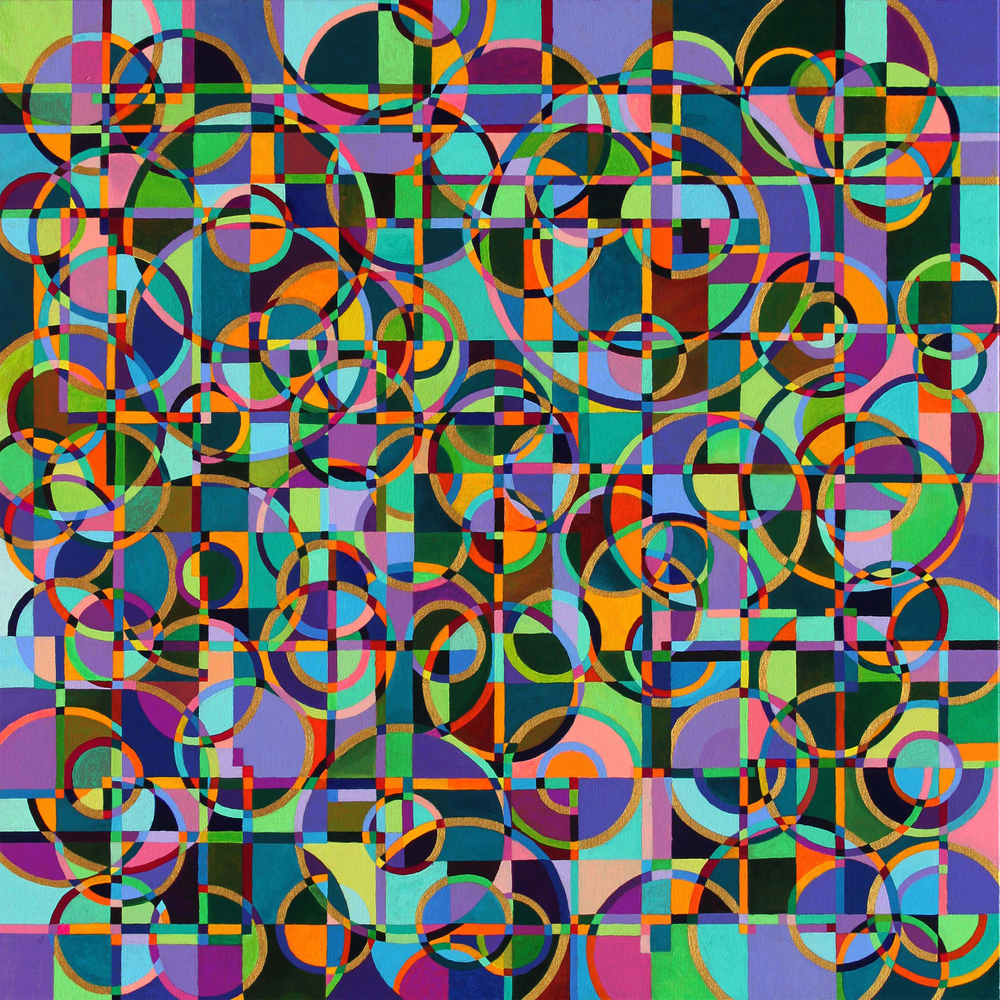I figured out pretty early on, age 4 or 5 maybe, that if I rubbed my eyes enough and then closed them I could see rather colorful kaleidoscopic afterimages that would change a bit each time I blinked. Similar effects were happening on the ground beneath leafy trees on sunny days, in the sky during fireworks displays, and swirling on the surface of soap bubbles. A thing was always changing in really cool ways, yet remaining that thing. See also: rivers, clouds, cities, living bodies, the proverbial ship that has had all its parts replaced over time. Those awakenings came later, but my fascination with all things dazzled, dappled, effervescent, morphing yet static, started early on.
Exploring these phenomena is a core driver in both my visual art and, to some extent, my music. Yes, I am working with pattern and density and often color, but my desire is to depict the dance of simultaneous change and stasis, whether it be a contained entity or something that could continue on in all directions forever. Making the ephemeral more permanent, a common goal of an artist, is also part of it. Freezing the soap bubble in time at the height of its beauty.
Easier said than done. I’m not a realist, so I employ more abstracted forms and try different approaches in my attempts to achieve said dance. Limiting myself in terms of shape and pattern types—a maximal minimalism if you will—helps to tie a piece together to keep it from becoming a mishmash of psychedelic soup.
“Soap Bubble” (2012)
“Emergence Refraction” (2017)
Cumulus" (2014)”
“Surfacing” (2014)
Over the past few years I’ve had the urge to get more 3-D. What if these shapes could emerge from the 2-D plane? That effort may have begun with my adventures in painting dowels, something I did between other projects or when I was stuck. Not sure what to do next? Paint patterns on a dowel. I really should write a separate blog post about the dowels. They are in some way a gathering of potential that has yet to be fully realized. I’ve got like a hundred of them at this point. They have, however, led to my painting of square (4-sided) dowels and their incorporation into many of the mixed media pieces later on in this post.
“How It’s Gonna Go Down” (2015)
But I get ahead of myself. One of my earliest 3-D pieces was “How It’s Gonna Go Down,’ a mixed media piece about climate change. It literally emerged from the wall as it was being swallowed by painted cellulose waves. I wanted to go more 3-D after that. See Blog post 4April 2018, the story behind the making of “Vibration Lands,” After THAT huge project, I reactively started making smaller pieces.
“Vibration Lands” (2018)
Messing about with drawing semi-random right angle geometries on paper, I cut then them out and constructed objects that seemed to suggest modernist houses, thinking that maybe I could eventually cut such forms out of opaque white plexiglass to make modular lighting fixtures.
A still-intriguing idea, but I got sidetracked, or at least differently-tracked: the paper cutouts got smaller, and I began to tinker. What emerged was a kind of maximal minimalism that suggested labyrinths, terraces, medina quarters, unknown depths, pixelated data arrays of unknowable meanings, leaves, petals and other organic strata (painted paper cutouts which I affixed to hidden wooden stilts.
“Peeling” (2018)
Data Filed I” (2018)
Data Filed II” (2018)
“Data Filed III” (2018)
Data Filed IV” (2018)
“Data Filed V” (2018)
I’d like to create some much larger pieces based on these paper constructions, but using sturdier materials like wood or even metal. The paper can be fragile and people seem to want to touch them (sometimes to the point of damage). Given the detail involved, I’m thinking laser cutting may be the route forward. Joining Nextfab and learning to operate their laser cutters and associated programs is high on my post-pandemic to-do list. I can see incorporating any number of my previous patterns into this design scheme.
In the mean time, my painted square dowels have become shorter, and I’ve started massing them in a somewhat similar fashion to the paper data fields.
“Little Cloud IV” (2020)
“Inner Space Station” (2020)
They first emerged as small, discrete arrangements, like a passing cloud formation. As I make these I feel like I’m creating little urban modules or neural clusters that want to be connected like cities or molecules. Perhaps even my blog posts have their own invisible connectors of idea and theme. I have the urge to draw way-finding arrows between blog texts and map it all out, connecting and highlighting the idea bubbles as they form and pop. My own personal Lego of art and words, caught in mid-morph. Am I getting closer to dancing about architecture? That, or am certainly in need of some social contact.
“Problem Solved” (2020) - Best viewed while listening to Terry Riley’s “A Rainbow in Curved Air”

















































